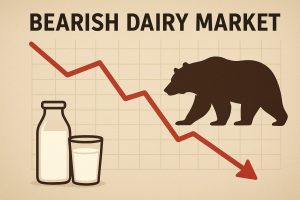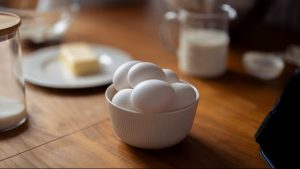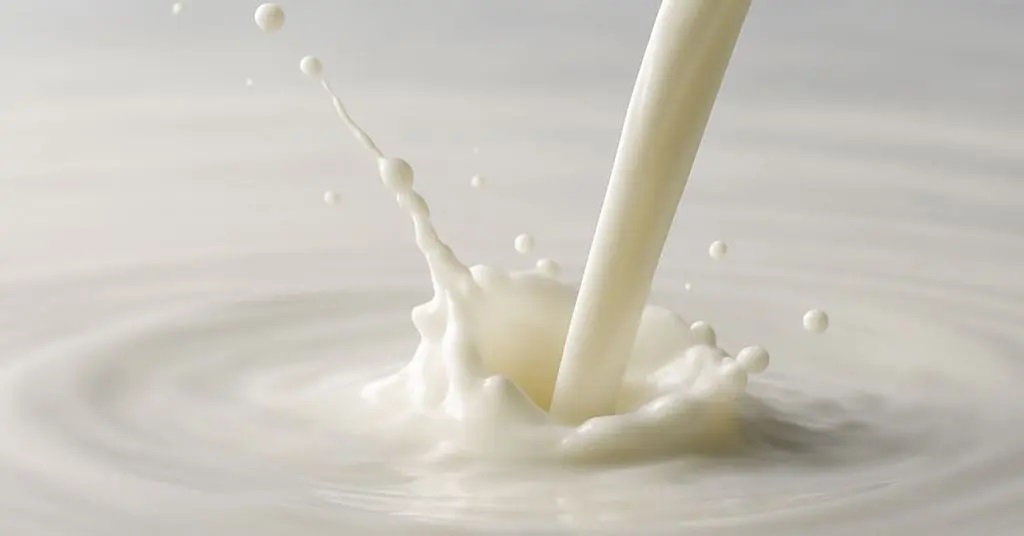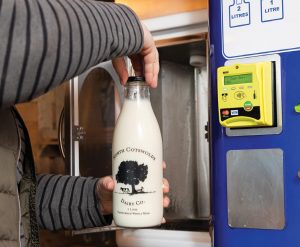
Tariffs remained the number one subject on a lot of people’s minds last week, particularly those in the dairy industry as the Trump Tariff Tit for Tat was changing almost by the hour.
Tariffs were increased on all trading partners of the U.S. and response was almost immediate, with some countries reciprocating, while others asked for further negotiation, prompting Trump to drop the tariffs back to the 10% level Wednesday and postpone the bigger increases for three months for about 75 countries.
The bellwether Standard and Poor’s 500 gained over 8% in minutes. Crude oil went from $4.00 lower on the day to $2.00 higher. Things reversed direction the next day. And, in the ongoing game of chicken with China which increased its tariffs to 125% on U.S. goods, Trump responded, raising China’s tariffs to 145%.
Speaking in the April 14 Dairy Radio Now broadcast, StoneX broker Dave Kurzawski said the resulting uncertainty in the markets is something they do not like but “food commodities fared better and remained rather stable.” The soybean market is watching closely as over half of U.S. beans are exported to China.
The bellwether spot cheese market made its most recent low on March 21, two weeks before “Liberation Day,” he said, and the futures market made its low, two days after April 2 Liberation Day. “U.S. cheese and butter prices remain attractive on the world stage, tariffs or no tariffs,” he concluded, and are “stable to higher.”
Rabobank Global Strategist, Mary Ledman, warned, “The escalating trade war between the U.S. and China is set to impact the global dairy market, particularly lactose and dry whey. With China imposing reciprocal tariffs on U.S. imports, the U.S. dairy sector, which exports over 50% of its dry whey and lactose production to China, faces potential disruptions. This could lead to shifts in trade dynamics, with the EU and UK possibly stepping in to fill the gap. The intensifying trade war could result in lower prices for U.S. dairy producers, slimmer margins for traders, and higher prices for Chinese end users and consumers,” Ledman warned.
The April 9 Daily Dairy Report (DDR) pointed out, “Milk production in China fell for the seventh straight month in February. CN Agri data showed that milk collections were 6.1 billion pounds in both January and February, with year-to-date output down 9.2% compared to January and February 2024. Milk prices in China fell 15% in February relative to February 2024, according to RaboResearch. And skim milk powder production in January and February plummeted more than 30% compared to the same months in 2024.”
Per capita dairy consumption in China is far below the rest of the world, says the DDR, and not keeping pace with gains in milk output there.
Interestingly, one of the reasons is “Many Chinese are lactose intolerant, which is why milk historically has not been a staple of the Chinese diet and why adoption is slow,” according to the DDR.
Back on the home front, you’ll recall February milk production was up 1.0% from a year ago, after factoring the Leap Day. Adjusting for the fat and protein components, it was up 3.5%. The February Dairy Products report shows where the milk was used, keeping in mind, February 2024 had 29 days and February 2025 had 28, a phenomenon which occurs about every four years so the totals are skewed.
Cheese output totaled 1.155 billion pounds, up 1.3% from Feb. 2024, adjusted for leap year. Revisions added 10.3 million pounds to January’s total. Output for the two months stood at 2.3 billion pounds, down 0.2% from 2024.
Mozzarella production totaled 373.3 million pounds, up 3.4% from a year ago, with year to date (YTD) output hitting 785.3 million pounds, up 1.7%.
Cheddar production hit 318 million pounds, up 1.0%, from a year ago. Revisions added 3 million pounds to the January total. Cheddar YTD hit 635.6 million pounds, down 1.5% from a year ago.
Butter production totaled 210 million pounds, up 12.4 million or 6.3% from a year ago, after increasing just 0.5% in January. YTD butter totaled 421.1 million pounds, up 1.5% from a year ago.
Weaker cheese, ice cream and sour cream production freed up some fat for butter, says StoneX.
Nonfat and skim milk powder production was up 0.2% from a year ago, which StoneX says is only the second time in 20 months that powder production has been up year over year.
HighGround Dairy (HGD) warned, “Ballooning nonfat dry milk stocks will make it hard for this market to stage a rally.”
Ditto on whey stocks, says HighGround. “Dry whey output tanked in February to the lowest volume for the month since the start of the century, yet stocks continued to build. Ultimately, trade wars will dictate the direction of this market.”
The Agriculture Department raised its milk production forecast from last month, in its latest World Agricultural Supply and Demand Estimates (WASDE) report, citing larger cow inventories and slightly higher milk per cow.
2025 production and marketings were projected at 226.9 and 225.9 billion pounds respectively, up 700 million on both. If realized, both would be up 1 billion pounds or 0.4% from 2024.
Imports are lower on both a fat and skim-solids basis, primarily due to additional duties placed on imported dairy products, in particular imports of butter fats and milk protein products. Exports on a skim-solid basis were reduced, primarily on lower shipments of dried skim milk products and whey products. Exports on a fat basis were raised on higher expected shipments of butter.
Prices for butter, cheese, nonfat dry milk (NDM), and whey were all lowered, based on recent prices and higher expected milk supplies.
The Class III milk price was lowered on anticipated lower cheese and whey prices. The 2025 average was projected at $17.60 per hundredweight, down 35 cents from last month’s estimate, and compares to $18.89 in 2024 and $17.02 in 2023. With April 10 settlements, the 2025 average would be $18.32.
The Class IV price was lowered on lower butter and nonfat dry milk prices and is expected to average $18.20, down 60 cents from a month ago, and compares to $20.75 in 2024 and $19.12 in 2023.
This month’s corn outlook included greater exports, reduced feed and residual use, and smaller ending stocks. Feed and residual use was cut 25 million bushels to 5.8 billion based on disappearance during the December-February quarter as indicated in the March 31 Grain Stocks report. Exports were raised 100 million bushels reflecting the pace of sales and shipments to date and relatively competitive U.S. prices. Ending stocks are down 75 million bushels from last month to 1.5 billion. The season-average corn price was unchanged at $4.35 per bushel.
Soybean supply and use included higher imports and crush, and lower ending stocks. The crush was raised 10 million bushels to 4.42 billion on higher soybean meal domestic use and soybean oil exports. Soybean oil for biofuel was lowered based on pace to date. However, stronger use is forecast for the last part of the marketing year due to tariffs impacting imports of other biofuel feedstocks. Soybean ending stocks were lowered 5 million bushels to 375 million. The U.S. season-average soybean price forecast was unchanged at $9.95 per bushel. Soybean meal was lowered $10 to $300 per short ton and the soybean oil price was raised 2 cents to 45 cents per pound, according to the WASDE.
The USDA’s first Crop Progress report of the season showed 2% of the U.S. corn crop was in the ground the week ending April 6, 1% behind a year ago, but dead even with the five-year average.
The USDA’s weekly Slaughter report shows 49,600 dairy cows were sent to slaughter the week ending March 29, down 2,900 from the previous week, and down 7,100 or 12.5% from a year ago. YTD, 693,600 head had been culled, down 54,200 head or 7.2% from a year ago.
CME block cheddar climbed to a Friday close at $1.7450 per pound, up 10.50 cents on the week, highest since March 13, and 21 cents above a year ago.
The cheddar barrels made it to $1.8050, 14.50 cents higher, highest since Feb. 27, 23.25 cents above a year ago, and an inverted 6 cents above the blocks. Sales for the week totaled 27 loads of block and 11 of barrel.
StoneX says “The level of skepticism on any market strength, be it spot or futures, is rather staggering these days. And for good reason as worries over demand and liquidity continue to plague outside energy and equity markets.” “Indecisive” might be a good description for the dairy complex yet cheese and butter remain attractively priced, both for U.S. and international buyers.
Midwest contacts told Dairy Market News (DMN) that cheese demand ranges from post-holiday order quiet to steady. Most said orders were steady after holiday deliveries had been prepared and/or out the door. Some cheesemakers were taking advantage of widely available and affordable spot milk, adding to production ahead of the upcoming seasonal demand. Milk prices are falling, with some as low as $5-under Class early in the week, while some were still around $1- under, according to DMN.
Seasonally stronger milk production is keeping a more than ample supply for western cheese manufacturers, but a few sellers reported they are receiving less than desired prices for their milk. Cheese output is steady to stronger. Inventories are mixed among manufacturers. Domestic retail cheese demand is steady to lighter and cheese has made its way into retail ads more often than usual recently. Food service demand continues to be less robust than retail and demand from international buyers is steady to strong, says DMN.
Cash butter made its way to a $2.3475 per pound Friday finish, 5.25 cents higher on the week but 57.25 cents below a year ago, with 30 trades for the week.
Central butter makers say spring holiday preparations are winding down. There is a sense that churning rates, which are and have been very active with ample cream, will likely throttle back ahead of post-holiday demand slowdowns and uncertainty in near-term export markets. Cream is growing slightly in availability, but multiples are holding in a steady pattern at and above 1.00, says DMN.
Cream remains steady for butter manufacturers in the West, but prices are ticking up a bit. Cream demand is somewhat stronger from dairy product manufacturers, including butter producers, though some are not willing to pay the higher prices. Many plants are running churns heavily to build inventory for later seasonal demand. Domestic retail demand varies from somewhat lighter to somewhat stronger. Some producers describe food service demand as weaker than this time last year while demand from international buyers is steady.
Grade A nonfat dry milk closed Friday at $1.1675 per pound, up a penny on the week and 2.50 cents above a year ago. There were 10 CME trades on the week.
StoneX says “Relations with Mexico appear to be on solid footing right now despite the otherwise tenuous trade relations for other U.S. destinations. With better supplies than previously expected and spotty demand, there remains little in the way of bullish news for powder.”
Dry whey closed the week 2.50 cents lower, slipping to 46.50 cents per pound, but still 10.50 cents above a year ago, with 11 sales reported for the week.
Tuesday’s Global Dairy Trade Pulse saw 3.7 million pounds of product sold, down from 4.2 million on the March 25 Pulse, and the lowest Pulse volume since June 25, 2024.
StoneX reports the winning price of Fonterra whole milk powder Regular Contract 2 was $3,980 U.S. per metric ton, unchanged from the GDT Event two weeks ago. Fonterra’s medium heat Contract 2 skim milk powder was $2,800 ($1.27), down 2.6% from the GDT Event last week, but up from the last Pulse auction.
Ending on a sweeter note, America’s top new and prototype ice cream flavors and novelty products competed for the title of “Most Innovative” at the recent International Dairy Foods Association’s annual Innovative Ice Cream Flavors and Products competition.
The event, co-sponsored by Dairy Foods magazine, is widely regarded as the premier showdown for frozen treat creators across the country and beyond. More than 260 industry professionals attended IDFA’s Ice Cream & Cultured Innovation Conference, featuring intense competition between classic flavors, such as brownie, coffee and mint, global flavors like “Yemeni Spiced Mocha” and “Thai Mango Sticky Rice,” and spicy options like “Blazing Mango Vanilla” and “Sweet Heat Peach.”
Lavender Lemon Butter Cookie by Kent Precision Foods Group took home top honors in the Most Innovative Ice Cream Flavor competition; Brownie Batter Cookie Dough by Hudsonville Ice Cream was awarded Most Innovative Ice Cream Novelty; and Dubai Bar Bliss by IRCA Group was named Most Innovative Prototype Ice Cream Flavor, the award for flavors not yet found in the marketplace, according to the IDFA.
Lee Mielke is a graduate of Brown Institute in Minneapolis, Minnesota. He’s formerly the voice of the radio show “DairyLine” and his column appears in agricultural papers across the U.S. Contact him at lkmielke@juno.com.
You can now read the most important #news on #eDairyNews #Whatsapp channels!!!
🇺🇸 eDairy News INGLÊS: https://whatsapp.com/channel/0029VaKsjzGDTkJyIN6hcP1K
























